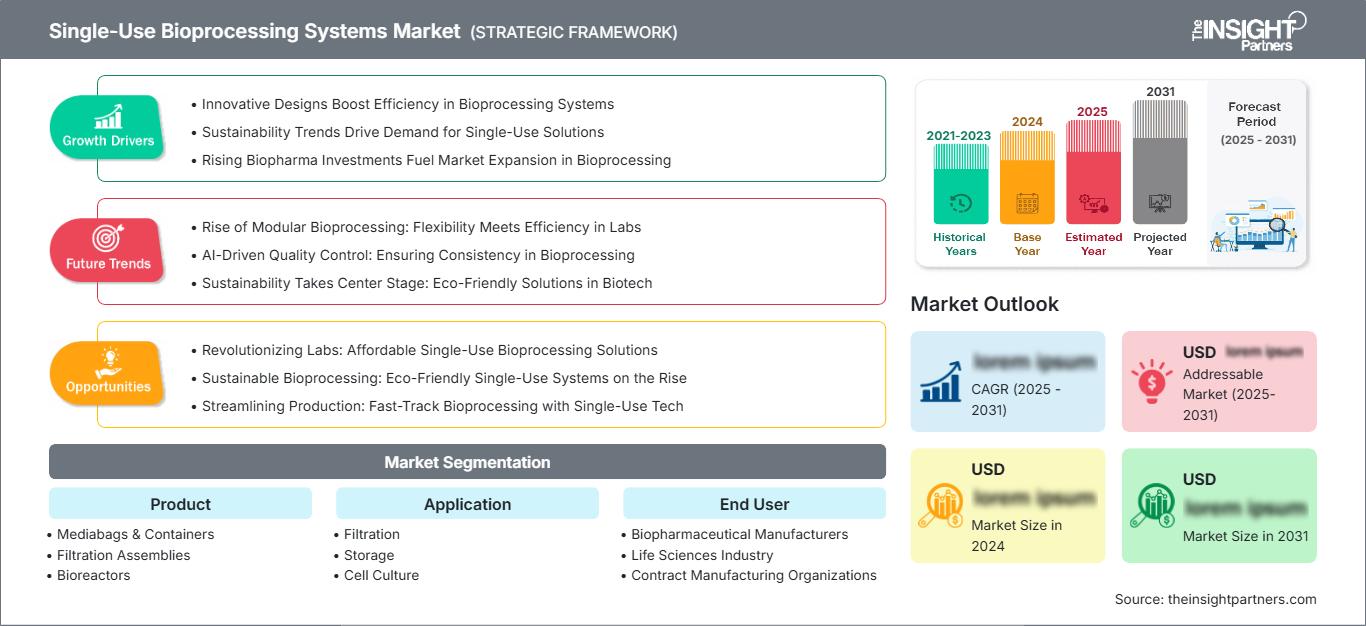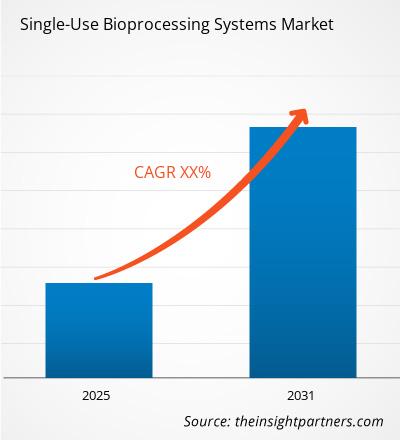Der Markt für Einweg-Bioprozesssysteme wird bis 2031 voraussichtlich ein Volumen von 82,34 Milliarden US-Dollar erreichen. Für den Zeitraum 2025–2031 wird ein jährliches Wachstum von 16,3 % erwartet.
Der Bericht ist nach Produktkategorien (Medienbeutel & -behälter, Filtrationssysteme, Bioreaktoren, Mischer) gegliedert und analysiert den Markt zudem nach Anwendung (Filtration, Lagerung, Zellkultur, Aufreinigung, Mischen). Darüber hinaus wird der Markt nach Endnutzer (Biopharmazeutische Hersteller, Life-Sciences-Industrie, Auftragsfertiger) untersucht. Für jedes dieser Schlüsselsegmente wird eine detaillierte Aufschlüsselung auf globaler, regionaler und Länderebene bereitgestellt. Der Bericht enthält Marktgrößen und Prognosen für alle Segmente, angegeben in US-Dollar. Der Bericht liefert zudem wichtige Statistiken zum aktuellen Marktstatus führender Akteure sowie Einblicke in vorherrschende Markttrends und neue Chancen.
Zweck des Berichts
Der Bericht „Markt für Einweg-Bioprozesssysteme“ von The Insight Partners beschreibt die aktuelle Marktlage und das zukünftige Wachstum, die wichtigsten Treiber, Herausforderungen und Chancen. Er bietet Einblicke für verschiedene Akteure im Markt, darunter:
- Technologieanbieter/Hersteller: Um die sich entwickelnde Marktdynamik zu verstehen und potenzielle Wachstumschancen zu erkennen, um fundierte strategische Entscheidungen treffen zu können.
- Investoren: Um eine umfassende Trendanalyse hinsichtlich Marktwachstumsrate, Finanzprognosen und Chancen entlang der Wertschöpfungskette durchzuführen.
- Regulierungsbehörden: Um Richtlinien zu regulieren und Aktivitäten auf dem Markt zu überwachen, mit dem Ziel, Missbrauch zu minimieren, das Vertrauen der Investoren zu wahren und die Integrität und Stabilität des Marktes zu gewährleisten. Marktsegmentierung für Einweg-Bioprozesssysteme: Produkt
- Medienbeutel & Behälter
- Filtrationssysteme
- Bioreaktoren
- Mischer
Anwendung
- Filtration
- Lagerung
- Zellkultur
- Reinigung
- Mischen
Endnutzer
- Biopharmazeutische Hersteller
- Life-Sciences-Industrie
- Auftragsfertigungsunternehmen
Passen Sie diesen Bericht Ihren Anforderungen anSie erhalten kostenlos Anpassungen an jedem Bericht, einschließlich Teilen dieses Berichts oder einer Analyse auf Länderebene, eines Excel-Datenpakets sowie tolle Angebote und Rabatte für Start-ups und Universitäten.
Markt für Einweg-Bioprozesssysteme: Strategische Einblicke

-
Holen Sie sich die wichtigsten Markttrends aus diesem Bericht.Dieses KOSTENLOSE Beispiel umfasst Datenanalysen, die von Markttrends bis hin zu Schätzungen und Prognosen reichen.
Wachstumstreiber des Marktes für Einweg-Bioprozesssysteme
- Innovative Designs steigern die Effizienz von Bioprozesssystemen
- Nachhaltigkeitstrends treiben die Nachfrage nach Einweglösungen an
- Steigende Investitionen in die Biopharmabranche beflügeln die Marktexpansion im Bereich Bioprozessierung
Zukunftstrends des Marktes für Einweg-Bioprozesssysteme
- Aufstieg der modularen Bioprozessierung: Flexibilität trifft auf Effizienz in Laboren
- KI-gestützte Qualitätskontrolle: Sicherstellung von Konsistenz in der Bioprozessierung
- Nachhaltigkeit im Fokus: Umweltfreundliche Lösungen in der Biotechnologie
Marktchancen für Einweg-Bioprozesssysteme
- Revolutionierung von Laboren: Erschwingliche Einweg-Bioprozesslösungen
- Nachhaltige Bioprozessierung: Umweltfreundlich Einwegsysteme auf dem Vormarsch
- Produktionsoptimierung: Beschleunigte Bioprozesse mit Einwegtechnologie
Markt für Einweg-Bioprozesssysteme
Die regionalen Trends und Einflussfaktoren auf den Markt für Einweg-Bioprozesssysteme im gesamten Prognosezeitraum wurden von den Analysten von The Insight Partners ausführlich erläutert. Dieser Abschnitt behandelt außerdem die Marktsegmente und die geografische Verteilung des Marktes für das Management von Herzrhythmusstörungen in Nordamerika, Europa, dem asiatisch-pazifischen Raum, dem Nahen Osten und Afrika sowie Süd- und Mittelamerika.
Umfang des Marktberichts zu Einweg-Bioprozesssystemen
By Anwendung- Filtration
- Lagerung
- Zellkultur
- Reinigung
- Mischen
- Biopharmazeutika-Hersteller
- Life-Science-Industrie
- Auftragsfertigungsunternehmen
- Großbritannien
- Deutschland
- Frankreich
- Russland
- Italien
- Restliches Europa
- China
- Indien
- Japan
- Australien
- Restlicher Asien-Pazifik
- Brasilien
- Argentinien
- Restliches Süd- und Mittelamerika
- Südafrika
- Saudi-Arabien
- Vereinigte Arabische Emirate
- Restlicher Naher Osten und Afrika
Berichtsattribut Einzelheiten Marktgröße in 2024 US$ XX Billion Marktgröße nach 2031 US$ 82.34 Billion Globale CAGR (2025 - 2031) 16.3% Historische Daten 2021-2023 Prognosezeitraum 2025-2031 Abgedeckte Segmente By Produkt - Medienbeutel und Behälter
- Filtrationsbaugruppen
- Bioreaktoren
- Mischer
Abgedeckte Regionen und Länder Nordamerika - USA
- Kanada
- Mexiko
Marktführer und wichtige Unternehmensprofile - Danaher
- Finesse
- General Electric Company
- PARKER HANNIFIN CORP
- PBS Biotech, Inc.
- 3M
- Applikon Biotechnology
- Eppendorf AG.
- MEISSNER FILTRATION PRODUCTS, INC.
Marktdichte bei Einweg-Bioprozesssystemen: Auswirkungen auf die Geschäftsdynamik
Der Markt für Einweg-Bioprozesssysteme wächst rasant, angetrieben durch die steigende Nachfrage der Endverbraucher. Gründe hierfür sind unter anderem sich wandelnde Verbraucherpräferenzen, technologische Fortschritte und ein wachsendes Bewusstsein für die Vorteile des Produkts. Mit steigender Nachfrage erweitern Unternehmen ihr Angebot, entwickeln innovative Lösungen, um den Kundenbedürfnissen gerecht zu werden, und nutzen neue Trends, was das Marktwachstum weiter ankurbelt.

- Holen Sie sich die Markt für Einweg-Bioprozesssysteme Übersicht der wichtigsten Akteure
Wichtigste Verkaufsargumente
- Umfassende Abdeckung: Der Bericht bietet eine umfassende Analyse der Produkte, Dienstleistungen, Typen und Endnutzer des Marktes für Einweg-Bioprozesssysteme und vermittelt so ein ganzheitliches Bild.
- Expertenanalyse: Der Bericht basiert auf dem fundierten Wissen von Branchenexperten und Analysten.
- Aktuelle Informationen: Der Bericht gewährleistet Geschäftsrelevanz durch die Berücksichtigung aktueller Informationen und Datentrends.
- Anpassungsmöglichkeiten: Dieser Bericht kann an spezifische Kundenanforderungen angepasst werden und sich optimal in die Geschäftsstrategien integrieren.
Der Forschungsbericht zum Markt für Einweg-Bioprozesssysteme kann somit maßgeblich dazu beitragen, das Branchenszenario und die Wachstumsaussichten zu entschlüsseln und zu verstehen. Auch wenn einige berechtigte Bedenken bestehen, überwiegen die Vorteile dieses Berichts insgesamt die Nachteile.
- Historische Analyse (2 Jahre), Basisjahr, Prognose (7 Jahre) mit CAGR
- PEST- und SWOT-Analyse
- Marktgröße Wert/Volumen – Global, Regional, Land
- Branchen- und Wettbewerbslandschaft
- Excel-Datensatz
Aktuelle Berichte
Verwandte Berichte
Erfahrungsberichte
Grund zum Kauf
- Fundierte Entscheidungsfindung
- Marktdynamik verstehen
- Wettbewerbsanalyse
- Kundeneinblicke
- Marktprognosen
- Risikominimierung
- Strategische Planung
- Investitionsbegründung
- Identifizierung neuer Märkte
- Verbesserung von Marketingstrategien
- Steigerung der Betriebseffizienz
- Anpassung an regulatorische Trends






















 Kostenlose Probe anfordern für - Markt für Einweg-Bioprozesssysteme
Kostenlose Probe anfordern für - Markt für Einweg-Bioprozesssysteme